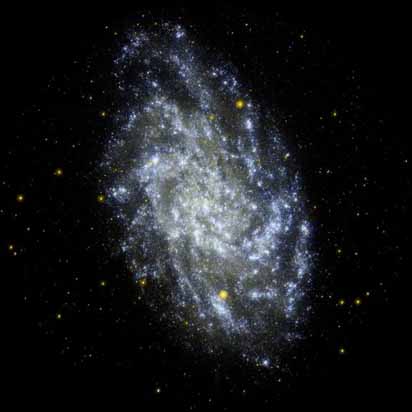Often times, objects that are unremarkable in one portion of the spectra, can often be vivid in others. In M33, the Triangulum Galaxy, a star that’s barely visible in the optical, stands out as the second brightest source (and single brightest single star) in the mid-infrared. This unusual star has been the target of a recent study, led by Rubab Khan at the Ohio State University and may help astronomers to understand an unusual supernova from 2008.
The supernova 2008S occurred February first in NGC 6946, the Fireworks Galaxy. Since it happened in a galaxy that is relatively nearby, astronomers seized the opportunity to explore the progenitor star in archival images. Yet images from the Large Binocular Telescope and other optical observatories could not find a star that could be identified as a parent. Instead, the detection of the star responsible came from Spitzer, an infrared observatory. Observations from this instrument indicated that the star responsible may have been unexpectedly low mass for such a powerful explosion leading other astronomers to question whether or not SN 2008S was a true supernova, or merely an impostor in the form of an eruption of a Luminous Blue Variable (LBV), which tend to be more massive stars and would be in stark contradiction to the Spitzer findings.
Yet, regardless of the nature of the nature of SN 2008S, teams all seemed to agree that the progenitor had only been detected in the infrared because it was veiled by a thick curtain of dust. So to help better understand this class of dusty stars, astronomers have been working to uncover more of them, against which they can test their hypotheses.
To find these objects, astronomers have been searching the infrared portion of the spectrum for objects that are exceptionally bright yet lack optical counterparts. The brightest of the stellar sources in M33 features faint star in the red portion of the optical spectrum from the Local Group Galaxies Survey published in 2007, but no star at all in archival records with similar limiting magnitudes from 1949 and 1991. The authors of the new study have dubbed this odd source, Object-X.
The team rules out the possibility that the object could be a young stellar object (YSO), blocked by a thick dust disc along the line of sight, noting that models of even the thickest dust discs still predict more light to be scattered back along the line of sight. Instead, the team concludes that Object-X must be a self-obscured star that has undergone relatively recent mass loss which has cooled to form either graphite or silicate dust. Depending on which type of dust is predominant, the team was able to fit the data to two wildly different temperatures for the star: either 5000 K for graphite, or 20,000 K for the silicate. In all cases, the predicted mass for the central star was always greater than 30 solar masses.
In general, there are two mechanisms by which a star can eject material to form such a curtain. The first is through stellar winds, which increase as the star enters the red giant phase, swelling up and lowering the force of gravity near the surface. The second is “impulsive mass ejections” in which stars shudder and throw mass off that way. A classical example of this is Eta Carinae. The team predicts from the features they found, that Object-X is most likely a cool hypergiant. The fact that the star was completely obscured until very recently hints that the mass loss is not constant (as stellar wind), but patchy, coming from frequent eruptions. As the shell of dust expands, the star should reemerge in the optical, becoming visible again in the next few decades.


Could this be classified under the same category?
I am surprised that this kind of thing does not happen more frequently.
Dyson sphere! ;D
@Navneeth: Looks pretty similar to me.
@Greg: The authors estimated that less than 1% of stars in a typical spiral galaxy are in this phase at any given time. However, that’s not to say that only 1% of stars go through this phase, but only that it is extremely short lived.
Has anyone thought to consider that the mid-infrared spectrum is synchrotron radiation in origin, rather than ‘thermal’ in orgin ?
And that ‘dust’ has nothing to do with it.
A weak magnetic field in the ISM, like what causes the radio lobes in Quasars either side of an active galaxy, is causing this large mid-IR field object to flouresce in the mid-IR range. Did anyone check the polarization properties of this particular emission spectrum ?
To quote from another article on UT today:
“Synchrotron radiation is a form of light produced when relativistic speed, charged particles move through a magnetic field. The light emitted can be generated in any portion of the spectra from radio to gamma rays, depending on the strength of the field. Astronomically, this was first detected in 1956 by Geoffrey Burbidge in the jets of M87 and has since been used to explain emission in planetary magnetospheres, supernovae, near black holes, and around pulsars.
This form of energy distinguishes itself from other forms of light in two main fashions. The first is that it is highly polarized. This property is generated by the electric and magnetic components always being in the same planes and can be studied with filters that only allow light with its fields in appropriate planes to pass. The second is that the radiation created is “non-thermal”. In other words, it doesn’t match the distribution of wavelengths generated by a blackbody.”
“Has anyone thought to consider that the mid-infrared spectrum is synchrotron radiation in origin, rather than ‘thermal’ in orgin ?”
The observed mid-IR spectral energy distribution is clearly thermal in origin, as illustrated in Figure 9 of the paper: http://arxiv4.library.cornell.edu/PS_cache/arxiv/pdf/1012/1012.3457v1.pdf
(and ‘dust’ does seem to be intimately involved)